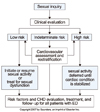Pharmacological Management of Male Sexual Dysfunction
Article information
Abstract
The erectile dysfunction (ED) and premature ejaculation (PE) are common medical conditions of male sexual dysfunction that affects the sexual lives of millions of men. While many drugs are now available for treating ED and PE, oral pharmacotherapy represents the first-line option for most patients. Phosphodiesterase type-5 (PDE5) inhibitors are currently the most widely prescribed oral agent and have a very satisfactory efficacy-safety profile in all ED patients' categories. Continuous treatments using PDE5 inhibitors and new agents including fast acting PDE5 inhibitors or other intracellular modulators are now under investigation. ED patients who do not respond to oral pharmacotherapy or who cannot use it are good candidates for intracavernosal injection therapy of which efficacy is high but the attrition rate remains significant. Since the pathophysiology of PE is still unclear and there is no approved treatment, it remains to be underdiagnosed and under-treated. The first-line pharmacotherapy for most PE patients is selective serotonin reuptake inhibitors (SSRI) because central 5-hydroxy tryptamine has been implicated as a key mediator of ejaculatory control. Topical anesthetics have also shown varying degrees of efficacy and tolerability. New agents being considered for the on-demand treatment of PE include tramadol and dapoxetine. Therapies for ED or PE will continue to develop as the understanding of those conditions expands. The purpose of this review is to describe the major recent novel advances in the field of medical therapy for the treatment of ED and PE.



